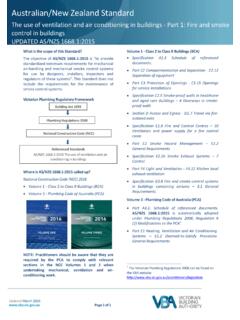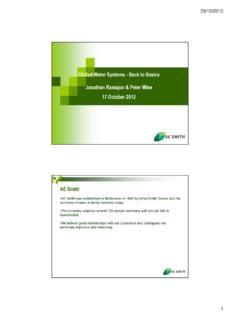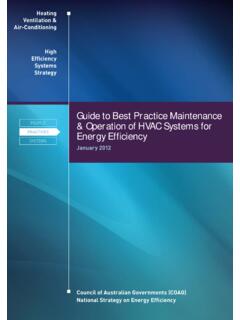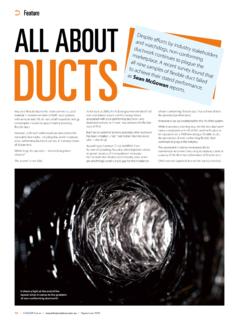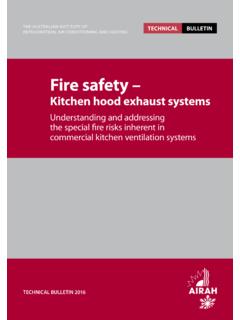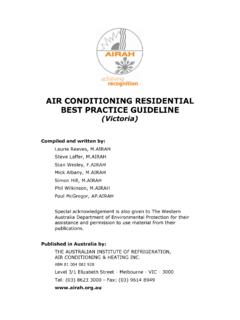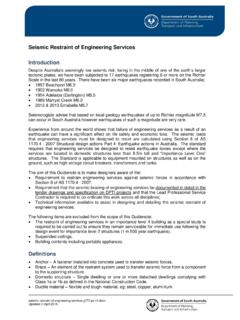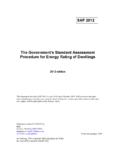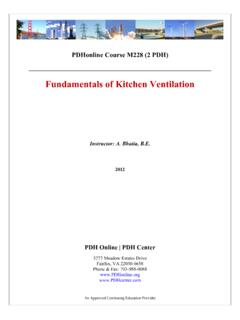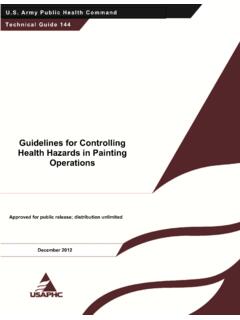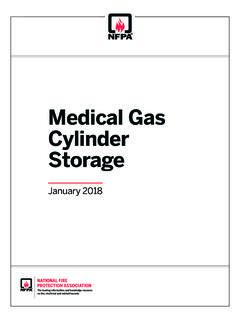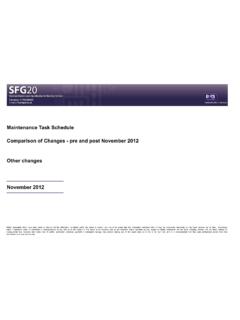Transcription of Implementation of revised AS 1668 Parts 2 & 4 — 2012
1 Implementation of revised AS 1668 Parts 2 & 4 2012 The use of airconditioning and ventilation in buildings Part 2: Mechanical ventilation Part 4: Natural ventilation Topics Overview Why, Where & How of ventilation Part 2 Mech. Vent Principal changes Details & Implications of changes Part 4 Natural Vent Principal changes & Details Overview Q: Why ventilate buildings? A: Amenity, Health and the Law oBuildings protect us from wind, rain, hail & heat, but also shield us from fresh air and capture contaminants oCooking smells & metabolic odours detract from amenity oLaboratories, factories, etc. contaminate with smells & toxins oRespect your neighbour. Exhaust mustn t be a nuisance oConstruction must comply with BCA, esp.
2 Part F4 oAS & AS are both required by Part F4 History of ventilation Standards oResearch on ventilation & perception of indoor air quality by Yaglou, Fanger et al, 1930s to present: Acceptable to 80% of visitors requires L/s/person Acceptable to 95% of visitors requires L/s/person More air required if activity is strenuous More air required for dilution if dust content is high oHigher productivity has recently been linked to 20 L/s per person oAustralian and international Standards were based on Yaglou research except in 1970s oil price shock! Overview Source Publication date or Period Typical rate per person Sydney ventilation Code 1963 & 1971 l/s Common Australian practice 1970s l/s ASHRAE 1972 l/s AS 1976 l/s Ordinance 70 (NSW) 1978 5 l/s AS 1980 l/s [ l/s in some cases] Sydney ventilation Code 1983 l/s AS 1991 10 l/s [ l/s to l/s] AS 2002 10 l/ s [ l/s to l/s] AS 2012 10 l/ s [ l/s to l/s] Sepp nen & Fisk + Bahnfleth 2006 & 2014 20 l/s (Productivity basis)
3 Reductions permitted if particulate filters only or odour + particulate filters are used Overview History of ventilation Standards oAll references to smoking removed oMech. ventilation in Pt. 2 & Natural ventilation in Pt. 4 oDilution Index of 2002 edition removed oO/A rates generally 10 L/s, with option to L/s or L/s oSimpler outdoor air calculations for complex spaces oMore kitchen hood types & cooking processes included oAutomatic demand control ventilation allowed AS 1668 Part 2 - 2012 Principal Changes Changes from the 1991 and 2002 editions oGuidance added on make-up air sources oDistance from inlets to small exhausts relaxed o2002 edition car park exhaust rates used oCar park natural vent.
4 Now in oSmall car park ventilation simpler & matches BCA oJet fans permitted to bend car park airflow oMechanical ventilation of health care now included oBig increase in exhaust from pools and spas AS 1668 Part 2 Principal Changes BCA 2013 & 2014 reference AS 2012 oVentilation of rooms oVentilation of Carparks oLocal exhaust ventilation of Kitchens oAir conditioning & ventilation esp. automatic contaminant control in Carparks BCA 2014 references AS 2012 oNatural ventilation of Carparks AS 1668 Part 2 Principal Changes AS 1668 Part 2 Details & Implications Supply Air oFloor wastes in ducts or plenums MUST always be charged oReliance on condensate only is not appropriate Enclosures prohibiting recycle air, increased to 9: oRooms where odours/noxious gases are produced or outgassed oPet shops, vet centres, kennels, etc.
5 OSwimming pools, decks, etc oEnclosures containing Specific contaminants AS 1668 Part 2 Details & Implications Supply Air Filters oMinimum filter ratings, now based on systems and airflow System characteristics Minimum filter rating (see AS ) 1000 L/s ducted G4 1000 L/s non-ducted G4 <1000 L/s ducted G2 <1000 L/s non-ducted NR Evaporative coolers NR LEGEND: NR = no requirement TABLE MINIMUM FILTER RATING AS 1668 Part 2 Details & Implications Minimum Outdoor Air supply oOutdoor air calculation based on 1991 Standard oConcept of Effective Outdoor Air allows credits for: Air-cleaning systems, Transfer from adjacent spaces, Unused O/A in recycle airstream, Odour & particulate filters oCalculation methods in Appendix D oThese are the minimum values noted in BCA (b)
6 AS 1668 Part 2 - 2012 Plant RoomConference RoomMeeting Room A33% OA25% OAMain Office15% OAAir-handling Unit serving Multiple EnclosuresFirst trial iteration for Outdoor Air flowAir CleanerSecondary Office15% OAOutdoor AirRecycle AirReturn AirSpill AirSupply Air25% OA AS 1668 Part 2 - 2012 Plant RoomConference RoomMeeting Room A33% OA25% OAMain Office15% OAAir-handling Unit serving Multiple Enclosures3rd iteration for Outdoor Air + Transfer AirSecondary Office15% OAAir CleanerOutdoor AirRecycle AirReturn AirSpill AirSupply AirTransfer Air18% OA AS 1668 Part 2 Details & Implications Demand Controlled supply ventilation oAutomatic operation of Outdoor Air Demand Control ventilation using population indicators.
7 Options are: Time-of-day schedules CO2 sensors Mixed gas sensors People counters AS 1668 Part 2 Details & Implications Exhaust Air oSupply air instead of exhaust is permitted where: Discharge is not objectionable, and Adjacent spaces are at higher pressure oFull Kitchen Exhaust exempted when only reheating food oBUT AS doesn t cover all exhaust ventilation , refer Appendix O eg: Explosion vents, Spray painting, Fume cupboards and Welding booths AS 1668 Part 2 Details & Implications Kitchen Hood Exhaust types oNow 7 different hood types. Additions are: Eyebrow hoods Ventilated ceilings Proprietary equipment oAnd 7 different cooking process types . Additions are: Oriental cooking tables and woks Bread ovens & steam-producing Combi oven Courtesy of Halton Closed ventilated ceilings envisaged in the Standard, incorporate direct duct connections to supply and exhaust AS 1668 Part 2 Details & Implications AS 1668 Part 2 Details & Implications Kitchen Hood Exhaust airflows oEnergy saving feature.
8 Exhaust velocity can be reduced to m/sec for hoods over non-grease-producing items oFurther reduction to m/s if hood volume is increased Kitchen Hood Exhaust discharges oConcessions allowed on separation from Kitchen Exhaust discharge to Air Intakes if odour filter or photochemical treatment is installed. Calculation methods provided AS 1668 Part 2 Details & Implications Filters & Ozone odour treatment AS 1668 Part 2 Details & Implications Make up of Exhaust Airflow oReflecting Section J Guidance is given on maximum flow of air-conditioned air for Kitchen Exhaust make-up air oWarning given on openable windows for make-up of residential exhausts. These may not be suitable sources AS 1668 Part 2 Details & Implications Separation of Exhausts & Air Intakes oExhaust discharges less than 1,000 L/s not required to be 6 metres from air intakes oDischarges less than 200 L/s can be 1 metre from intake oBut, multiple discharges less than 1,000 L/s within a 6 m radius are aggregated as one oPerhaps riser shafts no longer required in apartments?
9 Proximity of exhaust discharges & openable windows AS 1668 Part 2 Details & Implications AS 1668 Part 2 Details & Implications Carpark ventilation oMajor reduction in exhaust airflows, based on 2002 edition Small car parks: * 40 cars, same as BCA * Min airflow: 3,000 down to 2,000 L/s * Per vehicle rate: 500 down to 400 L/s * Area rate: down to L/s per m2 Large car parks: * 20% less flow by calculation * Entering cars not calculated * Extra factors for Vehicle type, Usage & Staff exposure AS 1668 Part 2 Details & Implications Carpark ventilation oMethods for reducing ventilation rates in small carparks simplified, options for automatic control with door switches & motion detectors oHigh/Low level exhaust outlets no longer required o Air moving devices are permitted to avoid extra ductwork where air paths are obstructed within the car park.
10 (Impulse fans or Jet fans) AS 1668 Part 2 Details & Implications Air moving device NOTE: This option allows ventilation of dead ends in car parks. Not to ventilate the whole car park Examples of Air Moving Devices Courtesy of Fantech AS 1668 Part 2 Details & Implications AS 1668 Part 2 Details & Implications Health Care Buildings oChange from the 1991 edition, but generally same as 2002 edition oApplies to: Operating theatres, Sterile Stores, Infectious & Protective isolation rooms, Recovery rooms, Autopsy rooms and Dirty utility rooms oSpecifies: Supply & Recirculation air change rates, Outdoor airflow, Filtration, Exhaust grille location and Room pressure versus adjacent areas Section 5.
